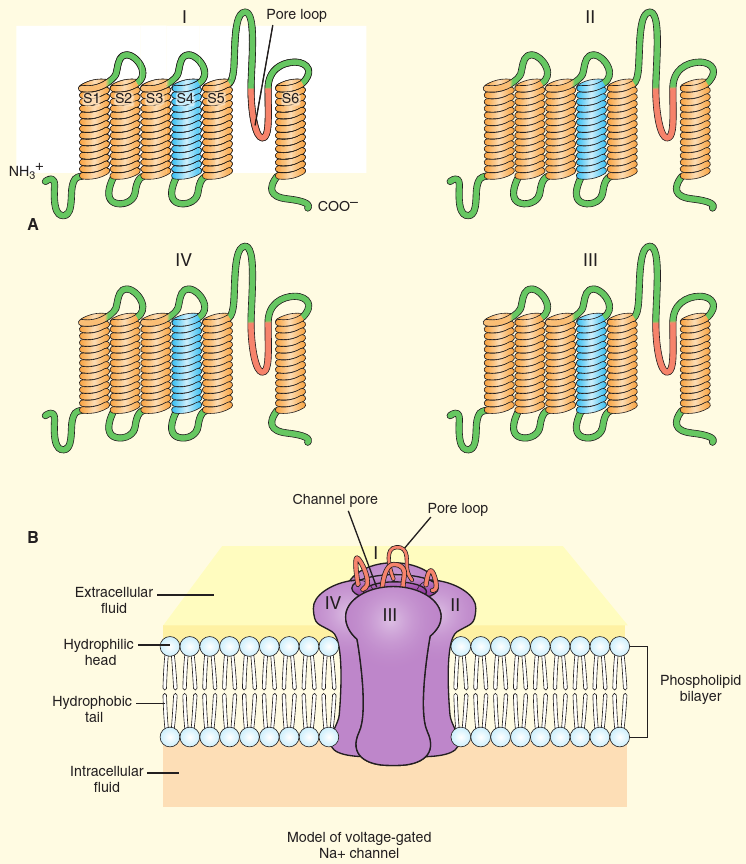Ion Channel
links: Ions reference: https://channelpedia.epfl.ch/wiki/ionchannels/188 5-7-2021
Ion Channels #
-
Responsible for most of the voltage in neurons. They span the membrane, allowing ions to diffuse back and forth across it.
-
Most neurons have higher concentrations of K+ inside (greater affinity) and Na+ outside.
-
There are:
- Ionotropic Neuroreceptors (ligand-gated ion channel)
- Lipid gated
- Voltage-gated channels (respond to membrane potential)
- For example, a voltage-gated sodium channel will respond to incoming action potentials and allow flow of Na+, resulting in further depolarization, resulting in a positive feedback loop.
- … and a few others.
-
The number of open nongated Na+ channels is much smaller than those of K+ (like 5% as much). The ~-65 mV resting potential is regulated and balanced, since the equilibriums are: K= -80 mV; Na = +62 mV; Ca = +123 mV; Cl = -65 mV; Mg = +9.26
- Why are two +1 anions so different? The gas contant ($R$) - $\ce K$ is much bigger in terms of moles. That’s what I originally suspected.
- Nernst equation/Nernst potential: $E=2.303 \frac{RT}{ZF}log \frac{[ion]_o}{[ion]_i}$ where Z= valence; F = faraday constant; o/i = ion concentration out-/in-side, and E = membrane equilibrium potential of an ion.
- Goldman Equation: actual membrane potential. $V_m = 61.5log\frac{{P_K[K^+]i + P{Na}[Na^+]i + P{Cl}[Cl^-]_i}}{P_K[K^+]o + P{Na}[Na^+]o + P{Cl}[Cl^-]_o}$
- (Permeabilities are basically determined physically)
Sodium Channels #

- The voltage-gated Na+ channel consists of four domains (I-IV) (and I’m not sure if this is the case for all tetramers (nope) - ) each with 6 hydrophobic alpha helices (S1-S6)
- *In general, the backbone hydrogen bonds of α-helices are considered slightly weaker than those found in β-sheets, and are readily attacked by the ambient water molecules. In more hydrophobic environments such as the plasma membrane, oligopeptides readily adopt stable α-helical structure
- As far as I know helices are folded in such a manner that the outer surface is hydrophilic while the inner surface is hydrophobic - it seems they balance out at best?
- The ribosome in which they’re synthesized - it’s an organelle, so it doesn’t have a bilayer membrane - but is submerged in cytoplasm. Not sure if the ribosome has a distinct local environment; I do know that it has no bearing on what proteins it can synthesize, and that hydrophobic peptides more readily make a run for it after synthesis.
- If we’re talking fluid, cyotosl is just water. It is polar.
- But it technically has various soluble proteins, cations like Na+ & K+, along with insoluble molecules and the cytoskeleton filaments like Actin. And then the organelles.
- If we’re talking fluid, cyotosl is just water. It is polar.
- The ribosome in which they’re synthesized - it’s an organelle, so it doesn’t have a bilayer membrane - but is submerged in cytoplasm. Not sure if the ribosome has a distinct local environment; I do know that it has no bearing on what proteins it can synthesize, and that hydrophobic peptides more readily make a run for it after synthesis.
- Pore loops make the channel more permeable to $\ce{Na+}$ than to $\ce{K+}$.
- Therefore I assume Potassium Channels do not have them if this is some physical chemical property?
- S4, as shown in blue, is voltage-sensitive. When the membrane is depolarized, S4 undergoes a conformation that pushes it away allowing Na+ influx.